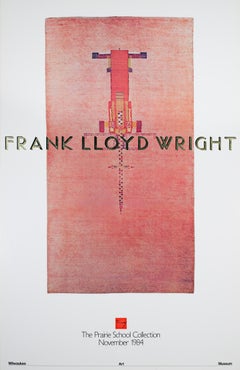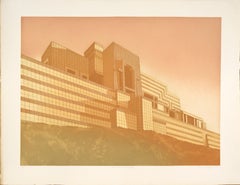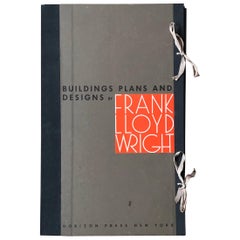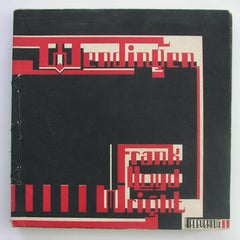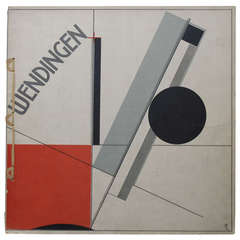Frank Lloyd Wright Lithograph
1980s American Modern Abstract Prints
Offset
Vintage 1960s American Prints
Paper
1980s Modern Landscape Prints
Paper, Ink, Lithograph
Vintage 1960s American Adirondack Prints
Paper
1920s American Modern Prints and Multiples
Lithograph
Early 20th Century Dutch Art Deco Books
Lithograph
Frank Lloyd Wright Lithograph For Sale on 1stDibs
How Much is a Frank Lloyd Wright Lithograph?
Finding the Right Prints-works-on-paper for You
Decorating with fine art prints — whether they’re figurative prints, abstract prints or another variety — has always been a practical way of bringing a space to life as well as bringing works by an artist you love into your home.
Pursued in the 1960s and ’70s, largely by Pop artists drawn to its associations with mass production, advertising, packaging and seriality, as well as those challenging the primacy of the Abstract Expressionist brushstroke, printmaking was embraced in the 1980s by painters and conceptual artists ranging from David Salle and Elizabeth Murray to Adrian Piper and Sherrie Levine.
Printmaking is the transfer of an image from one surface to another. An artist takes a material like stone, metal, wood or wax, carves, incises, draws or otherwise marks it with an image, inks or paints it and then transfers the image to a piece of paper or other material.
Fine art prints are frequently confused with their more commercial counterparts. After all, our closest connection to the printed image is through mass-produced newspapers, magazines and books, and many people don’t realize that even though prints are editions, they start with an original image created by an artist with the intent of reproducing it in a small batch. Fine art prints are created in strictly limited editions — 20 or 30 or maybe 50 — and are always based on an image created specifically to be made into an edition.
Many people think of revered Dutch artist Rembrandt as a painter but may not know that he was a printmaker as well. His prints have been preserved in time along with the work of other celebrated printmakers such as Pablo Picasso, Salvador Dalí and Andy Warhol. These fine art prints are still highly sought after by collectors.
“It’s another tool in the artist’s toolbox, just like painting or sculpture or anything else that an artist uses in the service of mark making or expressing him- or herself,” says International Fine Print Dealers Association (IFPDA) vice president Betsy Senior, of New York’s Betsy Senior Fine Art, Inc.
Because artist’s editions tend to be more affordable and available than his or her unique works, they’re more accessible and can be a great opportunity to bring a variety of colors, textures and shapes into a space.
For tight corners, select small fine art prints as opposed to the oversized bold piece you’ll hang as a focal point in the dining area. But be careful not to choose something that is too big for your space. And feel free to lean into it if need be — not every work needs picture-hanging hooks. Leaning a larger fine art print against the wall behind a bookcase can add a stylish installation-type dynamic to your living room. (Read more about how to arrange wall art here.)
Find fine art prints for sale on 1stDibs today.
- 1stDibs ExpertApril 5, 2022Frank Lloyd Wright broke away from Victorian-era architecture and created “Prairie-Style” out of the belief that there should be fewer, larger rooms that flowed easily. He was also a key player in the Art Deco movement. Shop a collection of expertly vetted Frank Lloyd Wright pieces from some of the world’s top sellers on 1stDibs.
- 1stDibs ExpertFebruary 1, 2024The style of Frank Lloyd Wright’s work is Prairie style. The architect pioneered the style, which draws inspiration from the natural beauty of the landscapes of the Midwest region of the U.S. Wright's design philosophy emphasized organic architecture, with buildings existing in harmony with their natural surroundings. His approach to architectural design had a profound influence on the shape of modern life, both while he was actively designing buildings and during the decades that followed. Shop a diverse assortment of Frank Lloyd Wright furniture on 1stDibs.
- 1stDibs ExpertMarch 22, 2022Yes, Frank Lloyd Wright designed furniture. He believed that the interior of a home should complement its exterior. As a result, he created unique pieces for many of the buildings he designed. Some of his most notable pieces include the Taliesin Group cabinet and the Allen table. Find a range of Frank Lloyd Wright furniture on 1stDibs.
- 1stDibs ExpertApril 5, 2022Yes, Frank Lloyd Wright made lamps. A stained-glass lamp he designed in the early 1900s was found at an antique shop in Chicago, abandoned during World War II. The lamp went on to break records at Christie’s auction, selling for over $700,000 in 1998. Shop a collection of expertly vetted Frank Lloyd Wright pieces from some of the world’s top sellers on 1stDibs.
- 1stDibs ExpertFebruary 27, 2024Frank Lloyd Wright used a variety of materials. For his homes and commercial buildings, the American architect favored natural materials and obtained them from local sources whenever possible. Some materials commonly featured in Wright's buildings include concrete, zinc, glass bricks, stone and wood. Wright’s wooden chairs and tables for his “Prairie Houses” of the early 1900s have sleek, attenuated forms, influenced by both the simplicity of traditional Japanese design and the work of Gustav Stickley and other designers of the Arts and Crafts movement. His desks and chairs for Johnson Wax have a streamlined look and feature tubular steel. Shop a variety of Frank Lloyd Wright furniture on 1stDibs.
- 1stDibs ExpertFebruary 27, 2024Frank Lloyd Wright's most famous house is arguably in Mill Run, a small community located in the Laurel Highlands region of southwestern Pennsylvania. Wright designed the home, called Fallingwater, in 1935 for the Kaufman family, who founded and owned a department store chain. Located around 70 miles southeast of Pittsburgh, the home is now open for daily tours. Just 7 miles away from Fallingwater is a second Frank Lloyd Wright home, Kentuck Knob. Designed in 1954, it was formerly the home of the Hagan family, who were friends with the Kaufmans. Explore a range of Frank Lloyd Wright furniture on 1stDibs.
- 1stDibs ExpertOctober 7, 2024The main difference between Frank Lloyd Wright and Le Corbusier is the architects’ philosophy. Frank Lloyd Wright helped pioneer organic architecture—buildings that coexist harmoniously with their natural surroundings. As a result, he often preferred to use natural and even local materials in his buildings and furniture. Le Corbusier was more progress-minded and sought to impose rational order on the world's chaos through design. He focused on designs for living in modern urban settings. In his furniture, he tended to blend natural and human-made materials, such as tubular chrome and genuine leather. On 1stDibs, shop a variety of Frank Lloyd Wright and Le Corbusier furniture.
- 1stDibs ExpertFebruary 27, 2024Frank Lloyd Wright designed more than 1,000 homes and other structures over the course of his life. However, only about 400 of those designs were ever built. Some of his most famous homes include Fallingwater, the Frederick C. Robie House, the Hollyhock House, the Darwin D. Martin House and Taliesin. Explore a diverse assortment of Frank Lloyd Wright furniture on 1stDibs.
- 1stDibs ExpertJune 6, 2024Around 430 Frank Lloyd Wright buildings are left. The American architect designed thousands of buildings throughout his career, but only 511 of his works were ever built. Some of these were lost to natural disasters, while others were demolished by their owners. On 1stDibs, explore an assortment of Frank Lloyd Wright furniture.
- 1stDibs ExpertApril 5, 2022Frank Lloyd Wright's architecture style was known as the Prairie Style; his principles led to a better life for all. From low-pitched roofs to overhanging eaves against closed-in Victorian era designs, prevalent in their confined spaces, among other things. Find vintage and modern Frank Lloyd Wright's pieces from top sellers on 1stDibs.
- 1stDibs ExpertFebruary 27, 2024The style of furniture that Frank Lloyd Wright used varied. Wright's wooden chairs and tables for his “Prairie Houses” of the early 1900s have sleek, attenuated forms, influenced by both the simplicity of traditional Japanese design and the work of Gustav Stickley and other designers of the Arts and Crafts movement. For several residential projects, Wright designed severely geometric chairs that are marvels of reductivist design. For the Price Tower in Oklahoma, Wright designed angular wooden desks as well as upholstered pedestal chairs made of chromed steel that are more in line with the mid-century modern style. On 1stDibs, shop a range of Frank Lloyd Wright furniture.
- 1stDibs ExpertApril 5, 2024There are four Frank Lloyd Wright houses in Pennsylvania. They include Fallingwater in Stewart Township, Kentuck Knob in Ohiopyle, Suntop Homes in Ardmore and the Don Duncan House in Acme. In addition, Wright designed the Francis Little House Library in Allentown and the Beth Sholom Synagogue in Elkins Park. On 1stDibs, explore a variety of Frank Lloyd Wright furniture.
- 1stDibs ExpertNovember 26, 2024The Robie House by Frank Lloyd Wright is called Prairie-style architecture because of its characteristics. Wright pioneered Prairie-style architecture by designing homes in the Midwest using inspiration from the prairie landscapes found in the region. The earthy colors and organic textures of the Robie House’s brick, stucco and wood materials bring to mind the color of the prairies, and its low-pitched roof, strong horizontal lines and elongated rectangular windows reflect the flatness of the terrain. Inside, the home features wide-open spaces that provide extended sight lines similar to how you can see far into the distance when gazing out across a flat prairie. Shop a collection of Frank Lloyd Wright furniture on 1stDibs.
Read More
Joan Mitchell’s Rare, Late-Career Diptych Buzzes with Life
Beneath the inky blackness, the painter’s irrepressible energy electrifies this pair of intaglio prints.
The 1stDibs Guide to Types of Abstract Art
Get to know the key movements and artists who have influenced visual culture for more than a century.
Romare Bearden’s Humanity Infuses His Bright, Bold Art
Through collage, painting and printmaking, the artist foregrounded Black life in America in revolutionary new ways.
Andy Warhol and Suzie Frankfurt’s ‘Wild Raspberries’ Cookbook Is an Artful, Fanciful Delight
This set of recipes and original prints might not make you a better chef. But it will make you smile.
Art Brings the Drama in These Intriguing 1stDibs 50 Spaces
The world’s top designers explain how they display art to elicit the natural (and supernatural) energy of home interiors.
Welcome (Back) to the Wild, Wonderful World of Walasse Ting
Americans are rediscovering the globe-trotting painter and poet, who was connected to all sorts of art movements across a long and varied career.
Shapero Modern’s Director Tells Us All about 20th-Century Prints
Tabitha Philpott-Kent knows a lot of art multiples. Here, the London gallery director talks about what makes printmaking so fabulous.
Yoshitomo Nara Puts a Punk Rock Twist on the Traditional Prints of His Ancestors
The forever-rebellious Japanese artist craftily defaces famous Edo Period woodblock prints with “In the Floating World.”
